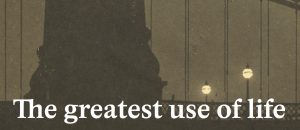John Kaag in Aeon:
 A year ago, on a late afternoon in November, I decided to walk the seven miles from my hotel in Manhattan to Brooklyn’s Community Bookstore. It was a cool day, on the cusp of evening, at a moment when things, even grimy New York-type of things, seem to glow, and I was so busy looking around that I almost didn’t notice the small white sign that someone had placed at the bottom of Brooklyn Bridge. The green lettering was newly painted and read: ‘LIFE IS WORTH LIVING.’
A year ago, on a late afternoon in November, I decided to walk the seven miles from my hotel in Manhattan to Brooklyn’s Community Bookstore. It was a cool day, on the cusp of evening, at a moment when things, even grimy New York-type of things, seem to glow, and I was so busy looking around that I almost didn’t notice the small white sign that someone had placed at the bottom of Brooklyn Bridge. The green lettering was newly painted and read: ‘LIFE IS WORTH LIVING.’
For many people, life’s worth is never in question. It never becomes a topic of conversation or debate. Life is simply lived until it is not. But something bothered me: if life’s worth is so obvious, why was the sign put up in the first place? It is because there are those of us who occasionally find themselves on the top of the bridge, contemplating a quick and fatal trip to the bottom. Decades after battling depression in 1870, the American philosopher William James wrote to the philosopher and poet Benjamin Paul Blood that ‘no man is educated who has never dallied with the thought of suicide’.
In the 1770s, David Hume, one of James’s intellectual heroes, had argued that self-murder should not be regarded as illegal or immoral since it hurt no one other than the perpetrator, and in many cases might alleviate great suffering. Romanticism, which arose in the subsequent generation of thinkers, only deepened the sense that life – and death – should be determined freely, by passionate individuals.
More here.
